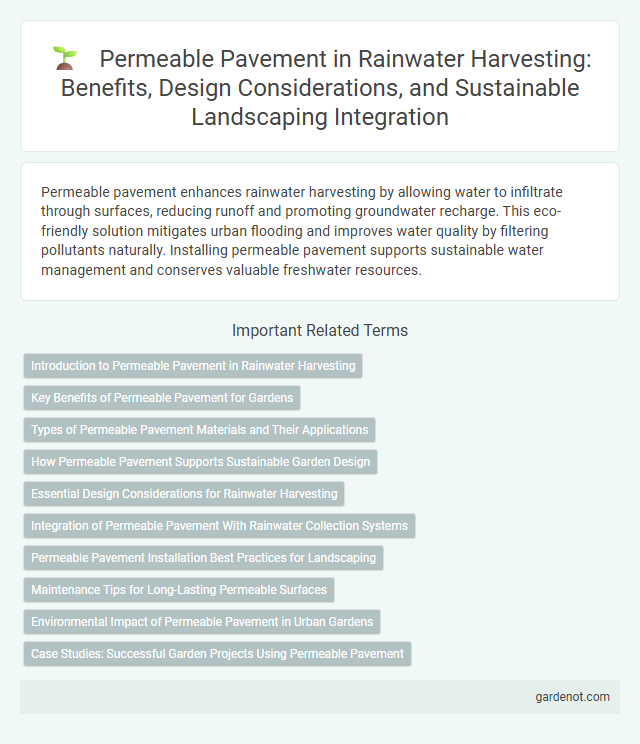Permeable pavement enhances rainwater harvesting by allowing water to infiltrate through surfaces, reducing runoff and promoting groundwater recharge. This eco-friendly solution mitigates urban flooding and improves water quality by filtering pollutants naturally. Installing permeable pavement supports sustainable water management and conserves valuable freshwater resources.
Introduction to Permeable Pavement in Rainwater Harvesting
Permeable pavement plays a crucial role in rainwater harvesting by allowing water to infiltrate through its surface, reducing runoff and promoting groundwater recharge. This innovative pavement design typically uses porous materials such as pervious concrete, porous asphalt, or interlocking pavers to capture and filter rainwater on-site. Implementing permeable pavement effectively mitigates urban flooding, improves water quality, and supports sustainable stormwater management.
Key Benefits of Permeable Pavement for Gardens
Permeable pavement enhances garden health by promoting natural groundwater recharge and reducing surface runoff, which minimizes soil erosion and nutrient loss. Its porous structure filters rainwater, removing pollutants and improving water quality for plants. This sustainable solution also mitigates urban heat island effects, creating a cooler environment that supports plant growth.
Types of Permeable Pavement Materials and Their Applications
Permeable pavement materials include porous asphalt, pervious concrete, and interlocking concrete pavers, each offering distinct benefits for rainwater harvesting by allowing stormwater infiltration and reducing runoff. Porous asphalt is commonly used in parking lots and low-traffic roads, while pervious concrete suits pedestrian walkways and residential driveways due to its high permeability and durability. Interlocking concrete pavers provide structural strength and aesthetic versatility, making them ideal for urban plazas and light traffic areas where both water drainage and design are important.
How Permeable Pavement Supports Sustainable Garden Design
Permeable pavement enhances sustainable garden design by allowing rainwater to infiltrate the soil, reducing surface runoff and promoting groundwater recharge. This method supports plant health through increased soil moisture retention and minimizes erosion by controlling water flow. Integrating permeable surfaces within garden landscapes improves water quality by filtering pollutants before they reach natural water bodies.
Essential Design Considerations for Rainwater Harvesting
Permeable pavement is crucial for effective rainwater harvesting, allowing water to infiltrate and reduce runoff. Key design considerations include selecting appropriate materials like porous asphalt or pervious concrete, ensuring sub-base layers promote infiltration, and accounting for soil permeability and expected rainfall intensity. Proper maintenance plans must be incorporated to prevent clogging and maintain long-term functionality of the permeable system.
Integration of Permeable Pavement With Rainwater Collection Systems
Permeable pavement enhances rainwater harvesting by allowing rainwater to infiltrate through its porous surface, reducing runoff and promoting groundwater recharge. Integrating permeable pavement with subsurface drainage and storage tanks optimizes rainwater collection, enabling efficient capture and reuse for irrigation and non-potable needs. This system minimizes urban flooding and supports sustainable water management in built environments.
Permeable Pavement Installation Best Practices for Landscaping
Permeable pavement installation for landscaping requires proper site assessment, including soil infiltration testing to ensure effective water absorption and prevent surface runoff. Utilizing layered substrates such as a base of crushed stone beneath the permeable materials enhances drainage and structural stability. Regular maintenance, including debris removal and inspection of joints, maximizes the pavement's longevity and rainwater infiltration capacity.
Maintenance Tips for Long-Lasting Permeable Surfaces
Regular cleaning of permeable pavement prevents clogging by debris and maintains optimal water infiltration rates. Scheduling annual inspections helps identify early signs of surface wear or sediment buildup, ensuring timely repairs. Using a vacuum sweeper or low-pressure water hose preserves the pavement's permeability and extends its functional lifespan.
Environmental Impact of Permeable Pavement in Urban Gardens
Permeable pavement significantly reduces stormwater runoff in urban gardens by allowing water to infiltrate the soil, which helps recharge groundwater and decreases the risk of flooding. Its porous structure filters pollutants, improving water quality and supporting healthier plant growth. This sustainable approach enhances urban biodiversity and mitigates the urban heat island effect by maintaining cooler soil temperatures.
Case Studies: Successful Garden Projects Using Permeable Pavement
Case studies of successful garden projects using permeable pavement highlight significant improvements in stormwater management and soil moisture retention. In cities like Portland and Melbourne, permeable pavement installations reduced runoff by up to 70%, promoting healthier plant growth and minimizing erosion in urban garden settings. These projects demonstrate the durability and effectiveness of permeable materials in sustainable landscape design and rainwater harvesting systems.
Permeable pavement Infographic

 gardenot.com
gardenot.com